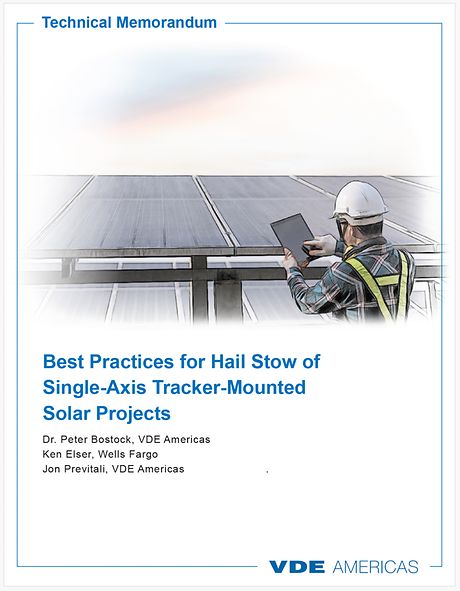VDE Americas and Wells Fargo Renewable Energy & Environmental Finance (REEF) have compiled recommendations and best practices for hail alert and defensive stow protocols for single-axis tracker-mounted solar power projects to guide sponsors, insurers, owners, developers, constructors, operators, and technical advisors.

Best practices for hail stow of single-axis tracker-mounted solar projects

Hail has proven to be among the largest property damage risks for solar projects in hail-prone regions. Although property insurance and warranties play a crucial role in mitigating these risks, they do not eliminate the perils associated with severe hailstorms. Insurance often does not cover all exposure, and warranties are subject to carve-outs, photovoltaic (PV) module design standard limitations, and burden of proof. Where PV module hail resilience is insufficient on its own to reduce the risk of hail damage to acceptable levels in utility-scale projects deployed using single-axis trackers, project stakeholders must use defensive hail stow procedures to enhance system-level resiliency.
Stowing single-axis tracker-mounted PV modules at a maximum tilt angle mitigates hail damage in two important ways: First, it can reduce the effective area of glass that is exposed to falling hail; second, it reduces the damage potential associated with hail impacts. Horizontally-oriented PV modules (i.e., 0° tilt or flat) are subject to the normal element of kinetic energy associated with falling hail (i.e., direct blows). Rotating PV modules to a tracker's maximum tilt angle (i.e., 50–75°) generally reduces the normal element of kinetic energy associated with falling hail (i.e., indirect or glancing blows), thereby significantly reducing the damage potential of hail impact.
According to insurance industry reports, hail accounts for less than 2% of solar project insurance claims by volume—but more than 50% of total dollar losses. Though some project locations will inevitably experience severe hail events, stakeholders can prevent or limit catastrophic hail damages with improved due diligence, technical literacy, and risk mitigation. The measures described in this memo are intended to mitigate hail risk through physical defenses against damage and should be understood as a supplement to hail insurance, PV module warranties, and appropriate equipment selection.